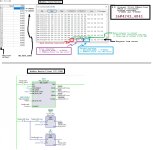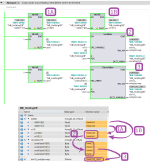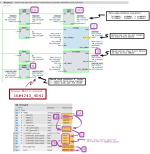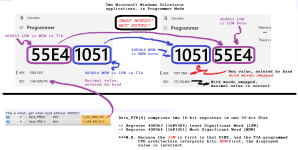AutoStudent88
Member
Hello!
I have made connection in TIA portal with an energy analyzer(Carlo Gavazzi EM26-96) using Modbus RTU.
What I am mainly looking for is the total kWH, which according to the manual is modicon address: 300063
In the MB_Master client I am using address: 400064 which after a lot of trial and error should be the correct address.
Now the problem arises, the value on the actual EM screen and in TIA are close but not the same.
I made simple code that calculates the hourly / kwh using the values I get from TIA and it comes out around 40 kwh/hr.
The value on the EM screen shows around 103kwh/hr.
Some things to note, when I use address 400002(which should be the first address) I get V L1 and address 400004 is V L2.
But when I use address 400006 I dont get V L3 but instead its V L1-L2. Making the think that its missing on the of V L-numbers. I assume its the V L1 I am somehow missing.
It would mean that all addresses are being shifted back by 1, but they arent since 400064 is still the total kwh(i think).
Another thing to note is that the values of kWh (+) L3 is not ticking up, but has been the same for at least the last 2 weeks. Where as the L1 and L2 keep ticking up.
The kWh tot and kWh par addresses are same value. Which is also concerning.
The energy analyzer has some DMD stuff happening, and some phases, could those have some impact on what I am reading in TIA portal?
Does anyone have any idea why this is happening, had similar issues or think I might be doing something wrong?
I have made connection in TIA portal with an energy analyzer(Carlo Gavazzi EM26-96) using Modbus RTU.
What I am mainly looking for is the total kWH, which according to the manual is modicon address: 300063
In the MB_Master client I am using address: 400064 which after a lot of trial and error should be the correct address.
Now the problem arises, the value on the actual EM screen and in TIA are close but not the same.
I made simple code that calculates the hourly / kwh using the values I get from TIA and it comes out around 40 kwh/hr.
The value on the EM screen shows around 103kwh/hr.
Some things to note, when I use address 400002(which should be the first address) I get V L1 and address 400004 is V L2.
But when I use address 400006 I dont get V L3 but instead its V L1-L2. Making the think that its missing on the of V L-numbers. I assume its the V L1 I am somehow missing.
It would mean that all addresses are being shifted back by 1, but they arent since 400064 is still the total kwh(i think).
Another thing to note is that the values of kWh (+) L3 is not ticking up, but has been the same for at least the last 2 weeks. Where as the L1 and L2 keep ticking up.
The kWh tot and kWh par addresses are same value. Which is also concerning.
The energy analyzer has some DMD stuff happening, and some phases, could those have some impact on what I am reading in TIA portal?
Does anyone have any idea why this is happening, had similar issues or think I might be doing something wrong?















